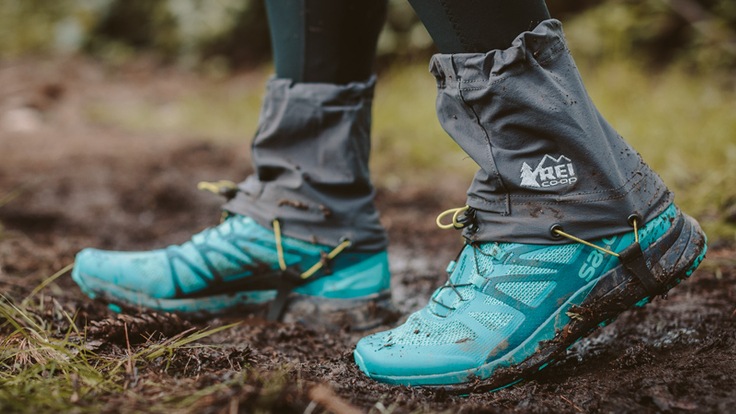Snow, water, dirt and pebbles have a way of sneaking into even the most waterproof of boots. To prevent this, put on some gaiters. Gaiters cover the vulnerable tops of your footwear to fully protect your feet from the elements.
Gaiter shopping is not complicated. This article will educate you on the different types of gaiters and help you choose the right ones based on the kind of trip you have planned, what conditions you're likely to encounter and what features you need. It also includes tips for putting gaiters on correctly and getting the best performance out of your gaiters.
Types of Gaiters
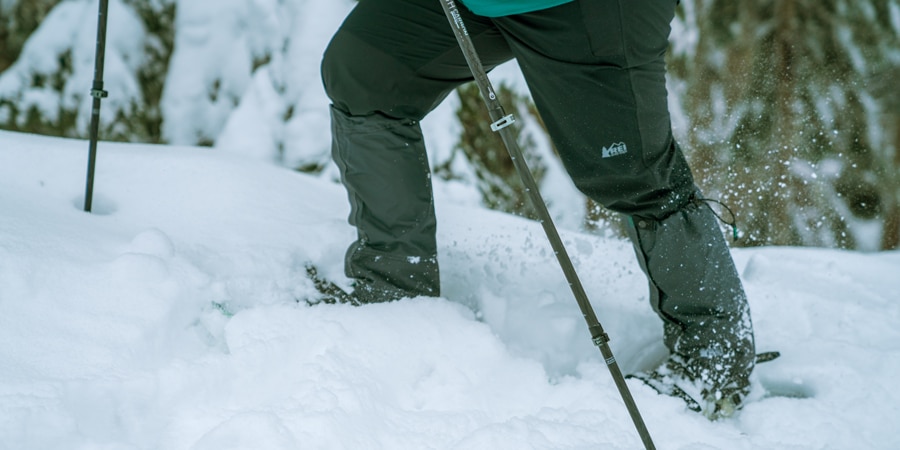
All gaiters have the same basic purpose: to keep stuff out of your boots. But the best type of gaiters for you depends on the kinds of trips you have planned and the weather and trail conditions you expect.
The main uses/types of gaiters include:
- Hiking: Gaiters for hiking are typically lightweight and breathable, and offer basic protection against rocks, grit and light rain while on mild-weather excursions. Some are fully waterproof for protection against rain and snow. Hiking gaiters are often used for everything from short day hikes to multiday backpacking trips.
- Mountaineering: Gaiters for mountaineering provide heavy-duty protection and some added insulation for extended trips in harsh conditions. Most feature a waterproof, breathable fabric for protection against rain and snow. In addition to mountaineering, these gaiters are frequently used for ice climbing, backcountry skiing, cross-country skiing and snowshoeing.
- Trail running: Gaiters for trail running are usually very lightweight and compact. Their main purpose is to keep debris out of your shoes while you're on the trail. They are typically not waterproof. Some ultralight hikers and thru-hikers who wear trail-running shoes will use these gaiters.
As you narrow your focus on a type of gaiter, remember that there is overlap between the different types. For example, mountaineering gaiters can be used for hiking, and in some cases may be the appropriate choice for where you're going and what the conditions are. Also, the uses of gaiters are not limited to hiking, mountaineering and trail running. If you have a need for keeping water, snow and/or debris out of your boots, find gaiters that offer the level of protection you need.
Gaiter Height
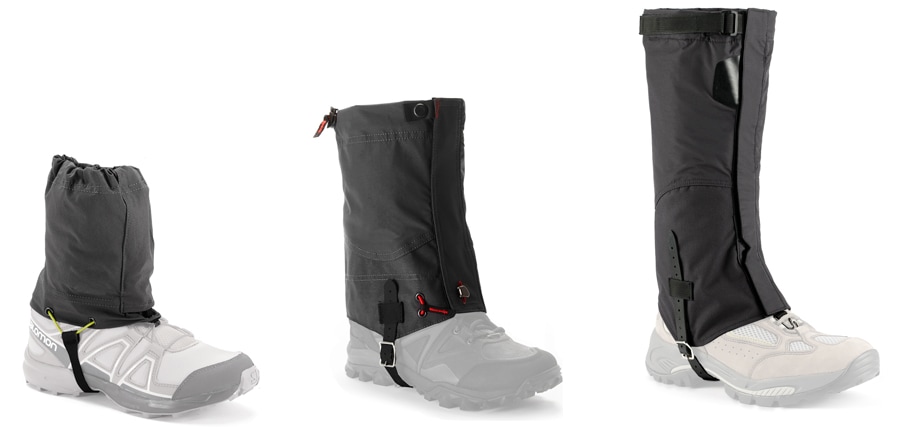
The appropriate gaiter height depends mostly on how much protection you need. Generally, for use in snow or when you're heading off trail, you'll want a taller gaiter for more coverage. Shorter gaiters are good for trail running and light hiking. It's worth noting that taller gaiters are generally hotter than shorter ones because they restrict airflow more—keep this in mind as you think about what conditions you're likely to use gaiters in.
Here are the three primary options for gaiter heights:
- Over-the-ankle: These low gaiters are primarily designed for trail-running or summertime hiking where the goal is to keep pebbles and other trail debris out of your shoes and boots.
- Mid-calf: These gaiters are usually about 8-to-12-inches tall. These are best for less-than-extreme conditions when you just need to keep trail debris and rain out of your boots.
- Knee: These are typically around 15-to-18-inches tall and are designed for rugged conditions such as hiking through deep snow and wet brush or in bad weather.
Gaiter Sizing
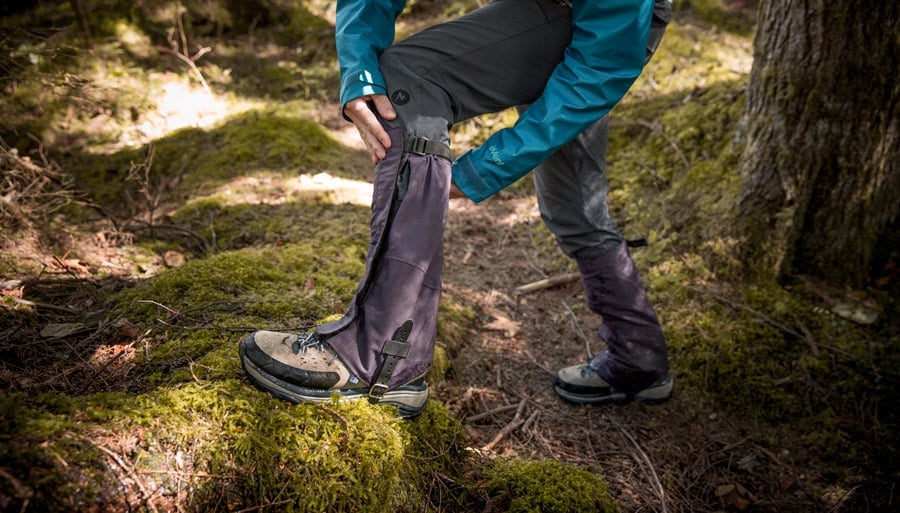
Getting the right size gaiters is important. When gaiters don't fit well, they can let water, snow and debris into your footwear and they can be uncomfortable to wear. Fortunately, getting the right size is straightforward.
Most gaiter styles come in sizes that are aligned with boot/shoe sizes. For example, most REI gaiters are sized like this:
Gaiter Sizes | ||||
|---|---|---|---|---|
| Small | Medium | Large | Extra Large |
U.S Men's Shoe Size | 5 - 7 | 6 - 9 | 8 - 11 | 10 - 13 |
U.S. Women's Shoe Size | 6.5 - 8.5 | 7.5 - 10.5 | 9.5 - 10.5 |
|
Your primary goal when sizing gaiters is to achieve the best possible seal around your boots/shoes to keep debris out. Ideally, they also fit comfortably snug around your legs and calves. When trying gaiters on, do so with the boots or shoes you plan to wear them with.
Sizing tips for hiking/mountaineering gaiters: When you try hiking or mountaineering gaiters on to confirm they fit correctly, look at how closely the gaiters fit around your boots. There shouldn't be obvious loose areas or openings for moisture to get in. Also, pay attention to how the gaiters fit around your legs and calves. If you have larger calves, you can use the hook-and-loop entry system to adjust the fit—you don't need to overlap the hook-and-loop fastener all the way. Generally, a half-inch of overlap is sufficient. Really large boots, like mountaineering boots or snowboard boots, may require you to size up.
Sizing tips for running gaiters: When trying on running gaiters, look closely at how they are designed to attach to your shoes. Some have hook-and-loop patches that connect to your shoes at the heels (provided your shoes also have hook-and-loop patches on them). Others have instep straps like hiking/mountaineering gaiters. When you put them on, pay attention to how the gaiters feel around your ankles and lower shins to determine whether they will rub and cause discomfort. When sized correctly, running gaiters should be snug but not uncomfortable, and they should stay securely attached to your shoes without riding up.
Gaiter Features
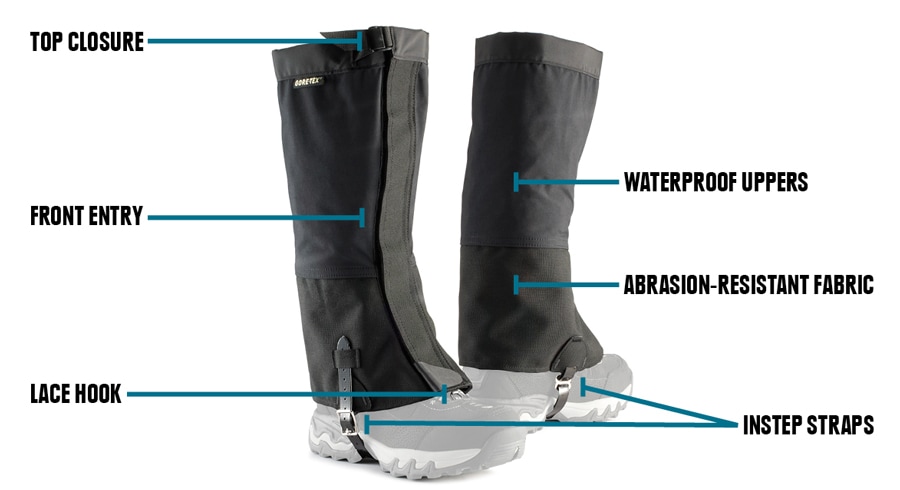
Waterproof: Gaiters for mountaineering and snowsports are typically made with a waterproof, breathable material to keep moisture from snow and glaciers out of your boots. If you'll be tromping through wet or snowy conditions, look for waterproof gaiters.
Insect repellent: Occasionally, you'll find gaiters that are treated with an insect repellent to help keep mosquitoes, ticks and other biting insects away. This can be helpful for hiking and backpacking in areas known to be buggy.
Abrasion-resistant fabric: Some gaiters include rugged abrasion-resistant nylon on the lower portion. It's designed to withstand the abrasion of ice, rocks and the occasional nick from crampon points.
Soft-shell fabric: Soft-shell fabric offers flexibility and stretch as well as excellent weather protection.
Coated nylon: Basic gaiters are very light and are usually made with polyurethane-coated nylon. If a short day hike or fast-packing through talus, sand or wet brush is on your agenda, this type of fabric will work just fine.
Entry system: Gaiters for hiking and mountaineering are usually opened and secured by long strips of hook-and-loop fastener (VELCRO® brand or similar) down the fronts of the gaiters.
Top closures: Basic gaiters are typically cinched with toggles and elasticized drawcords; some models feature a dedicated top strap with cam buckle.
Instep straps: These secure the lower edge of your gaiters around your boots' insteps. Basic gaiters come with simple lace straps. Premium gaiters feature beefier leather/synthetic straps for extra durability.
Lace hooks: Offered on some styles, these let you attach your boot laces to your gaiters for added security.
How to Put Gaiters On
Gaiters aren't particularly complicated. That said, we've seen them put on every which way. So, whether you're getting ready for a hike or going to a store to try gaiters, follow these steps for wearing them correctly. (Note: These instructions are for most styles of hiking/mountaineering gaiters. Not all gaiters have the same features and, therefore, may not follow these steps exactly.)
- Position the gaiters so the hook-and-loop closures are in front: As you step into the gaiters, the fabric should wrap around behind your legs and the openings should be in front.
- Place the instep strap buckles to the outside: Put the gaiters on so that the buckles on the instep straps are to the outside of your feet. If you place them on the inside, you may accidentally kick the buckles while walking. Also, make sure the instep straps run through the instep areas of your boots or shoes.
- Adjust the instep straps: On some gaiters, particularly those with internal instep straps, you need to adjust the instep straps to the appropriate length first before completely putting the gaiters on. Gaiters with external instep straps can be adjusted after they are on and you have closed the hook-and-loop fasteners in step 5. Either way, the goal is to snug the straps up so that the bottoms of the gaiters make a nice tight seal around your boots or shoes. If you're using the same footwear with your gaiters every time, you should only have to adjust the instep straps once.
- Engage the lace hooks: On gaiters that have lace hooks, try to hook the laces as far down on your boots as you can reasonably reach. On bigger boots, like those for mountaineering, you probably won't be able to reach all the way to the laces closest to the toes.
- Close the hook-and-loop closures: Secure the long strips of hook-and-loop fastener that run down the fronts of the gaiters together. If you have large calves, you don't need to overlap the fastener all the way—a half-inch overlap is sufficient.
- Snug the top closures: You don't need to overtighten the straps at the tops of the gaiters. Just snug them up so the gaiters won't slip down your legs. Overtightening will be uncomfortable.
- Secure other closures: Some gaiters have snaps or other styles of closures at the top and/or bottom to keep the gaiters from loosening up. Secure these before heading out.
Tip: In a downpour, try wearing your gaiters underneath your rain pants to create a shingled effect that effectively sheds rain. If you wear your gaiters over your pants, rain can run down your pants, underneath the gaiters and into your boots.
